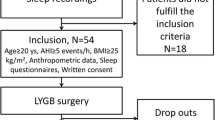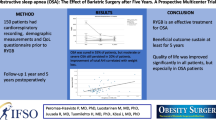Abstract
Background
Bariatric surgery can effectively treat obesity and improve OSAHS. However, the exact underlying mechanisms remain unclear. The objective of this follow-up study is to explore the main factors associated with the efficacy of Roux-en-Y gastric bypass surgery (RYGB) on obstructive sleep apnea-hypopnea syndrome (OSAHS).
Methods
A total of 39 OSAHS patients with obesity and type 2 diabetes mellitus (T2DM) who had received RYGB surgery were recruited. A polysomnography test was carried out in all subjects before surgery and postoperative 6 to 12 months, and the following tests were performed: fasting glucose, lipid profile, electrolyte levels, and liver and kidney function tests. The paired Student’s t test, Pearson test, Spearman correlation test, and multiple linear regression analysis were used to explore the effects of RYGB surgery on these indices and investigate the main factors associated with postoperative efficacy.
Results
RYGB surgery significantly lowered the apnea-hypopnea index (AHI), body mass index (BMI), and concentrations of total albumin, prealbumin, retinol-binding protein, total cholesterol, triglycerides, fasting blood glucose, albumin, and C-reactive protein, while postoperative blood magnesium levels were significantly increased (p < 0.05). Changes in the AHI (delta AHI) were correlated with delta BMI (r = 0.408, p = 0.010) and delta prealbumin levels (r = 0.495, p = 0.001). However, no significant correlation was found between delta BMI and delta prealbumin. The delta AHI were assessed by multiple linear analysis as follows: delta AHI = 0.105 × (delta prealbumin) + 1.509 × (delta BMI) + 1.006.
Conclusions
RYGB is an effective therapeutic option for OSAHS patients with obesity and T2DM; the potential factors associated with postoperative efficacy include changes in BMI and prealbumin levels.





Similar content being viewed by others
References
Gao XM, Zhao Y, Zeng XL, et al. Epidemiological studies of snoring and sleep apnea syndrome in the Beijing area. Chin J Orthod. 1997;4:162–5.
Cheng Y, Zhang J, Zhou W, et al. The current situation of sleep apnea and OSAHS survey in Ningxia. J Ningxia Med Univ. 2009;31(5):604–6.
Knauert M, Naik S, Gillespie MB, et al. Clinical consequences and economic costs of untreated obstructive sleep apnea syndrome. World J Otorhinolaryngol-Head Neck Surg. 2015;1(1):17–27.
Group SDB, Society R, Association CM. The guidelines for patients with obstructive sleep apnea hypopnea syndrome (2011 Revised Edition). Chin J Tuberc Respir Dis. 2012;35(3):9–12.
Namyslowski G, Scierski W, Mrowk-Kata K, Kawecka I, Kawecki D, Czecior E. Sleep study in patients with overweight and obesity. J Physiol Pharmacol. 2005;56(6):59–65.
Sjöström L, Lindroos AK, Peltonen M, et al. Lifestyle, diabetes, and cardiovascular risk factors 10 years after bariatric surgery. N Engl J Med. 2004;351(26):2683–93.
De Dios JA, Brass SD. New and unconventional treatments for obstructive sleep apnea. Neurotherapeutics. 2012;9(4):702–9.
Xiel H, Doherty L, O’Boyle C. The positive impact of bariatric surgery on sleep. Ir Med J. 2016;109(1):328–30.
Greenburg DL, Lettieri CJ, Eliasson AH. Effects of surgical weight loss on measures of obstructive sleep apnea: a meta-analysis. Am J Med. 2009;122(6):535–42.
Fritscher LG, Mottin CC, Canani S, et al. Obesity and obstructive sleep apnea-hypopnea syndrome: the impact of bariatric surgery. Obes Surg. 2007;17(1):95–9.
Zou J, Zhang P, Yu H, et al. Effect of laparoscopic Roux-en-Y gastric bypass surgery on obstructive sleep apnea in a Chinese population with obesity and T2DM. Obes Surg. 2015;25(8):1446–53.
Simpson L, Mukherjee S, Cooper MN, et al. Sex differences in the association of regional fat distribution with the severity of obstructive sleep apnea. Sleep. 2010;33(4):467–74.
Abramson Z, Susarla S, August M, et al. Three-dimensional computed tomographic analysis of airway anatomy in patients with obstructive sleep apnea. J Oral Maxillofac Surg. 2010;68(2):354–62.
Sutherland K, Lee RW, Phillips CL, et al. Effect of weight loss on upper airway size and facial fat in men with obstructive sleep apnoea. Thorax. 2011;66(9):797–803.
Li M, Zhen GC, Wen YL, et al. Changes of C-reactive protein level and inflammatory factors in patients with obstructive sleep apnea syndrome. J Clin Med Pract. 2014;18(9):19–21.
Chen D, Bao L, Lu SQ, et al. Serum albumin and prealbumin predict the poor outcome of traumatic brain injury. Plos One. 2014;9(3), e93167.
Liu N, Xiao J, Wen XH, et al. The diagnostic value of retinol-binding protein and prealbumin for liver, kidney and thyroid diseases. Shanxi Med J. 2012;41(6):607–9.
Hansson LO, Hedlund JU, Ortqvist AB. Sequential changes of inflammatory and nutritional markers in patients with community-acquired pneumonia. Scand J Clin Lab Invest. 1997;57(2):111–8.
Vega A, Quiroga B, Abad S, et al. Study on overhydration in dialysis patients and its association with inflammation. Nefrologia. 2014;34(5):579–83.
Collins N. The difference between albumin and prealbumin. Adv Skin Wound Care. 2001;14(5):235–6.
Molfino A, Heymsfield SB, Zhu F, et al. Prealbumin is associated with visceral fat mass in patients receiving hemodialysis. J Ren Nutr. 2013;23(6):406–10.
Zhou X. Clinical biochemistry and laboratory [M]. Third Edition. Beijing: People’s Medical. 2004; 445.
Teixeira TF, Collado MC, Ferreira CL, et al. Potential mechanisms for the emerging link between obesity and increased intestinal permeability. Nutr Res. 2012;32(9):637–47. PMID: 23084636.
Qin YY, Lin Y. The relationships among obstructive sleep apnea-hypopnea syndrome, osteopontin and inflammatory reaction. J Southeast Univ (Med Sci Edit). 2012;31(3):369–72.
Klöting N, Graham TE, Berndt J, et al. Serum retinol-binding protein is more highly expressed in visceral than in subcutaneous adipose tissue and is a marker of intra-abdominal fat mass. Cell Metab. 2007;6(1):79–87.
Reaven GM. Role of insulin resistance in human disease (syndrome X): an expanded definition. Annu Rev Med. 1993;44(1):121–31.
Zhan Y, Tang ZH, Yu YS, et al. Changes and clinical significance of serum retinol-binding protein and prealbumin in patients with viral hepatitis B. Chin J Modern Med. 2009;19(17):2693–5.
O’Brien PE. Bariatric surgery: mechanisms, indications and outcomes. J Gastroenterol Hepatol. 2010;25(8):1358–65. PMID: 20659224.
Ionut V, Bergman RN. Mechanisms responsible for excess weight loss after bariatric surgery. J Diabetes Sci Technol. 2011;5(5):1263–82.
Liu R, Lu JM, Liu JF, et al. Influence of obstructive sleep apnea syndrome on blood glucose control and occurrence of chronic diabetic complications in type 2 diabetes patients. Med J Chin PLA. 2012;37(12):1130–4.
Iiyori N, Alonso LC, Li J, et al. Intermittent hypoxia causes insulin resistance in lean mice independent of autonomic activity. Am J Respir Crit Care Med. 2007;175(8):851–7.
Buxton OM, Pavlova M, Reid EW, et al. Sleep restriction for 1 week reduces insulin sensitivity in healthy men. Diabetes. 2010;59(9):2126–33.
Lin QC, Chen LD, Yu YH, et al. Obstructive sleep apnea syndrome is associated with metabolic syndrome and inflammation. Eur Arch Otorhinolaryngol. 2014;271(4):825–31.
Zemel MB. Mechanisms of dairy modulation of adiposity. J Nutr. 2003;133(1):252S–6.
Wang BT, Hou J, Zhang XH, et al. Correlation between blood trace elements and obstructive sleep apnea hypopnea syndrome in children. J Otolaryngol Ophthalmol Shandong Univ. 2012;26(1):19–21.
Lv XH, Wang RS. Influence of magnesium on endothelial cell lipid peroxidation and antioxidant enzymes. Acta Nutrimenta Sin. 2001;23(3):250–3.
Zhao WJ, Wei SQ. Changes of serum magnesium level in patients with diabetes mellitus in pre-therapy and post-treatment. Heilongjiang Med J. 1997;10(5):309–10.
Liu XX. The research development of trace element iron. Trace Elements Sci. 2001;8(1):11–5.
Author information
Authors and Affiliations
Corresponding author
Ethics declarations
Conflict of Interest
The authors declare that they have no conflicts of interest.
Statement of Informed Consent
Informed consent was obtained from all individual participants included in the study.
Statement of Human and Animal Rights
This study was approved by the Ethics Committee of the Shanghai Jiao Tong University Affiliated Sixth People’s Hospital and complied with the Declaration of Helsinki.
Electronic supplementary material
Below is the link to the electronic supplementary material.
Supplementary Table 1
(DOC 16 kb)
Rights and permissions
About this article
Cite this article
Jiao, X., Zou, J., Zhang, P. et al. Roux-en-Y Gastric Bypass Surgery on Obstructive Sleep Apnea-Hypopnea Syndrome: Factors Associated with Postoperative Efficacy. OBES SURG 26, 2924–2930 (2016). https://doi.org/10.1007/s11695-016-2209-x
Published:
Issue Date:
DOI: https://doi.org/10.1007/s11695-016-2209-x




